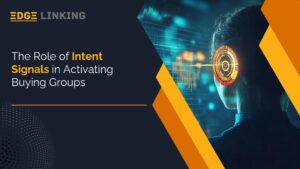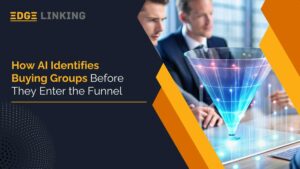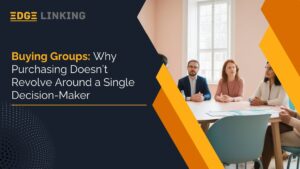A customer scrolls past your LinkedIn ad, which is relevant to the pain points of a problem they have been researching. A week later, they read a blog on the website and downloaded a whitepaper. Then, a few days later, they attend a webinar, and after a personalized demo, they accept your offer.
The entire scenario is the result of a well-orchestrated, full-funnel demand engine.
In today’s landscape, prospects don’t decide to purchase after watching an ad. They gather information, consult peers, compare alternatives, and expect timely content at every stage. A full-funnel demand engine enables this experience from the initial touchpoint to the final one.
So, why does the full funnel demand engine matter in B2B?
B2B has multiple stakeholders, long sales cycles, and trust is a significant factor. One who pushes for a hard sell too soon may lose the prospect before the conversation starts. The full-funnel approach bridges these gaps, meeting the right buyer at the right time and place.
This article will guide you through the steps to build a comprehensive demand engine.
Foundation: Aligning Sales and Marketing
Here’s how to build a solid foundation for a full-funnel demand engine.
1.Shared Goals and KPIs
To create a seamless buyer journey, both teams should align around shared metrics such as
Marketing Qualified Leads (MQLs)
Sales Accepted Leads (SALs)
Conversion rates at each funnel stage
Pipeline contribution by source
Revenue influenced by marketing
Example: A SaaS company aligns marketing and sales by setting a joint quarterly goal: 500 MQLs with a 30% SAL rate and $2M in an influencer pipeline. Both teams track progress on a weekly basis using shared dashboards.
2.Creating a Service Level Agreement (SLA)
An SLA outlines what marketing commits to delivering (e.g., volume and quality of leads) and what sales agree to do in return (e.g., follow-up timelines and feedback loops).
Example: Marketing commits to delivering 200 MQLs per month, complete with lead data. Sales, in turn, agree to follow up with each lead within 24 hours and provide status updates in the CRM within 3 days. The SLA is reviewed monthly in a joint meeting.
3.Unified Lead Scoring and Lifecycle Stages
Marketing and sales need a shared definition of what makes a lead “qualified.” This is where lead scoring comes in, such as ranking prospects based on behavior (e.g., page views, downloads) and firmographics (e.g., company size, industry).
Example: A cybersecurity firm uses a lead scoring model were downloading a high-intent asset, such as a pricing guide, adds more points than reading a blog. Leads crossing a particular score are flagged as MQLs and routed to sales for follow-up.
Building Blocks of a Full-Funnel Engine
A high-performing full-funnel demand engine knows how to activate each stage of the funnel to turn prospects into pipelines.
Top of Funnel (Tofu): Driving Awareness
The top-of-the-funnel goal is not to sell but to educate, inspire, and attract your target audience.
1.Brand Storytelling & Thought Leadership
Share your brand’s point of view on industry trends through blogs, LinkedIn posts, and founder videos.
Example: A fintech startup publishes a LinkedIn series on “The Future of Decentralized Finance,” positioning its leaders as trusted experts.
2.Paid Media (LinkedIn, Google Ads, Display)
Target decision-makers use interest and job-title filters to promote helpful content.
Example: A SaaS company runs LinkedIn video ads promoting a free industry report for CFOs in tech companies.
3.Organic Content (SEO blogs, videos, podcasts)
Focus on answering top-of-funnel questions through optimized SEO content.
Example: An HR platform ranks on Google for “how to scale remote onboarding” through long-form blog content and a YouTube explainer.
4.Influencer & Community Engagement
Partner with niche influencers or host AMAs in LinkedIn communities.
Example: A MarTech brand collaborates with a RevOps influencer to co-host a “growth hacks” live session.
Middle of Funnel (MoFu): Driving Engagement
Here, you capture interest and build deeper connections with your target audience.
1.Gated Content (Whitepapers, Webinars)
Offer valuable resources in exchange for information, such as the email ID of your target audience.
Example: An AI startup hosts a webinar on “Automating Lead Scoring,” which collects leads in a single session.
2.Email Nurturing & Retargeting
Keep the conversation going with behavior-based email sequences and dynamic ads.
Example: Leads who downloaded a guide receive a drip campaign with case studies and testimonials.
3.ABM Campaigns
Target key accounts with personalized messages and landing pages.
Example: A cybersecurity firm runs ABM ads featuring a company’s logo and security pain points.
4.Intent Data for Messaging
Use tools like Bombora to refine outreach based on buying signals.
Example: Sales gets notified when a target account starts researching “cloud compliance,” triggering outreach.
Bottom of Funnel (BoFu): Driving Conversion
At this stage, your job is to arm sales with the tools they need to close the deal.
1.Sales Enablement Content (Case Studies, ROI Tools)
Provide materials that demonstrate impact.
Example: An analytics company shares a case study showing 3x ROI in 6 months.
2.Personalized Demos & Consultations
Tailor demos to the buyer’s role and industry.
Example: A logistics platform customizes its demo for a retail brand, highlighting features such as real-time inventory sync.
3.Smart CTAs & Landing Pages
Use persuasive pages with personalized CTAs to drive action.
Example: A landing page dynamically updates based on the visitor’s company name and job title.
4.AI/CRM Integration
Automate follow-ups, qualify leads, and provide sales reps with real-time insights.
Example: An AI-powered CRM flags deal at risk and suggest the following best actions based on buyer behavior.
Measuring & Optimizing the Funnel
Here are the keyways to measure and optimize your funnel.
1.Track Key Metrics by Funnel Stage
Each funnel stage has its success indicators. By tracking these, you can understand where breakdowns are happening.
Top of Funnel (ToFu): Impressions, clicks, website traffic, content downloads
Middle of Funnel (MoFu): MQLs, webinar attendance, email open/click rates
Bottom of Funnel (BoFu): Sales Qualified Leads (SQLs), conversion rate to opportunity, win rate
Example: An HRTech company notices high traffic to their blog but low conversion to leads. This insight pushes them to add stronger CTAs and gated content for MQLs.
2.Attribution Modeling: Single-Touch vs. Multi-Touch
Understanding what influenced a deal is key.
Single-touch attribution assigns all the credit to a single touchpoint (e.g., the first click or last click).
Multi-touch attribution distributes credit across all interactions where buyers engage multiple times before making a conversion.
Example: A cybersecurity firm shifts from last-click to multi-touch attribution and discovers that their podcasts and mid-funnel webinars play a bigger role in closing deals.
3.A/B Testing
Test different versions of landing pages, CTAs, email subject lines, and ad creatives to determine which ones perform better.
Example: A SaaS platform A/B tests two demo request landing pages, one with a testimonial and one without.
4.Identifying Leaks in the Funnel
Use conversion rates between stages to spot where leads are dropping off. Are people downloading content but never becoming MQLs? Are MQLs not converting to SQLs?
Example: A supply chain tech company realizes MQL-to-SQL conversion is low. After testing, they find marketing is sending leads too early, so they adjust the lead scoring model.
Common Pitfalls to Avoid
Here are three common mistakes that can derail your demand generation efforts.
1.Over-focusing on Top-of-Funnel (ToFu) with No Conversion Strategy
Many marketers celebrate high impressions or content downloads without a clear plan to nurture those leads through the funnel.
Example: A SaaS company runs a successful paid campaign that generates thousands of whitepaper downloads. However, they don’t have a follow-up sequence or sales enablement strategy.
Fix: For every ToFu campaign, plan the whole journey. What gated content leads to a webinar? What email sequence follows a download? What sales outreach happens after an MQL is created?
2.Misaligned Messaging Across Funnel Stages
Another common pitfall is using the same messaging for all funnel stages. What works for awareness will not resonate with buyers who are evaluating solutions or comparing vendors.
Example: A cybersecurity firm uses high-level “why security matters” messaging in both its blog content and demo pages. But at BoFu, buyers want specifics such as technical capabilities, customer success stories, and ROI.
Fix: Align your messaging to buyer intent. Early-stage prospects need education and insight; mid-funnel leads want use cases and proof points; bottom-funnel prospects are looking for differentiation and outcomes.
3.Failing to Operationalize Intent Signals
Many use tools like LinkedIn Insights to collect intent data but fail to act on it in real-time.
Example: A marketing team notices that a key account is showing significant interest in “compliance automation,” but the sales team isn’t notified. The opportunity is missed.
Fix: Integrate intent data into your full-funnel demand engine workflows. Set up alerts, tailor messaging, and launch outreach based on buyer behavior.
Conclusion
It’s not about perfection from day one. It’s about progress. Start with the basics, build momentum, and optimize based on performance and feedback. Every tweak brings you closer to a demand engine that turns customers and advocates.






